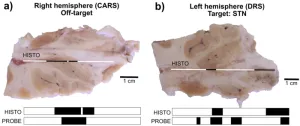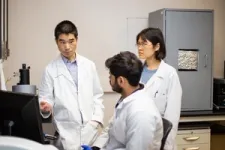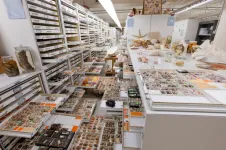(Press-News.org) VANCOUVER -- Deep brain stimulation (DBS) has become an increasingly common treatment for patients with advanced Parkinson’s disease, but the procedure still carries significant risks. A new probe that performs two types of spectroscopy could make the procedure safer and improve success rates by helping doctors more accurately navigate instruments inside the brain. The research team identified white and grey matter using principal component analysis (PCA), proving that spectroscopic measurements could be suitable for neuronavigation.
For DBS, surgeons place electrodes in the brain to disrupt the errant signals that cause debilitating tremors and stiffness associated with advanced Parkinson’s disease. It can be a remarkably effective treatment for patients who no longer benefit from available medications, but placing an electrode in the wrong spot can reduce the effectiveness and lead to psychological disorders.
Mireille Quémener from CERVO Brain Research Center (Université Laval) in Québec will detail the new research at Optica’s Biophotonics Congress being held in Vancouver, British Columbia and online 23 – 27 April 2023. Quémener’s presentation is scheduled for Thursday, 27 April at 12:15 PDT (UTC – 07:00).
“Improving neurosurgical guidance for the DBS electrode insertion would streamline the surgical process, decrease the surgery time, reduce the overall health treatment cost and prevent adverse neuropsychological consequences,” said Quémener.
Real-time navigation support
DBS is a two-part procedure, including one surgery to place electrodes in specific parts of the brain and a second surgery to implant a battery pack that delivers electrical current to the electrodes. For the first procedure, doctors typically rely on pre-surgery magnetic resonance imaging (MRI) scans to plan where they will insert electrodes. However, this can sometimes lead to an inaccurate placement since the brain can shift by up to 2 mm during the process of drilling an access hole through the skull.
In the new work, researchers created a DBS electrode that is enhanced with an optical probe to perform coherent anti-Stokes Raman scattering spectroscopy (CARS) and diffuse reflectance spectroscopy (DRS) on brain tissues during the insertion process. The probe fits within the DBS electrode and contains two fibers for CARS and DRS illumination and a third fiber for collecting the signals. Once the electrode reaches the target position, the optical probe can be while the electrode stays in place.
Confirming accuracy
To test the new probe, a neurosurgeon used it to implant electrodes in six regions of the brain of a human cadaver. CARS and DRS measurements were collected along a total length of 50 mm in each of the brain’s two hemispheres. After the procedure, researchers extracted the brain and visually identified the white and grey matter through which the probe had passed.
Comparing the readouts from the CARS and DRS measurements to the visual record of brain structures, the researchers found the CARS and DRS methods identified brain tissue with great accuracy. These findings confirm that spectroscopy could be a useful tool to help neurosurgeons navigate the brain.
The researchers plan to study whether the approach could be used to collect even more detailed spectroscopic information, for example to measure neurotransmitters that provide a chemical signature of brain activity.
“Our team is currently working on adapting the optical probe to use it in clinical trials for patients who will receive a DBS surgery. We are convinced that optical methods have enormous potential for surgical guidance, and hope that our technology will emerge in the clinic to assist surgeons in various brain procedures,” said Quémener.
About Optica Biophotonics Congress
Optica Biophotonics Congress is an annual meeting that focuses on biomedical optics and optics in the life sciences in alternating years. The 2023 meeting, Optica Biophotonics Congress: Optics in the Life Sciences, explores the latest tools and techniques in optical imaging with a focus on advanced techniques for microscopic imaging and related applications. The meeting will be presented in a hybrid conference format with in-person and virtual participation options. More information at https://www.optica.org/en-us/events/congress/biophotonics_congress/.
About Optica
Optica (formerly OSA), Advancing Optics and Photonics Worldwide, is the society dedicated to promoting the generation, application, archiving and dissemination of knowledge in the field. Founded in 1916, it is the leading organization for scientists, engineers, business professionals, students and others interested in the science of light. Optica’s renowned publications, meetings, online resources and in-person activities fuel discoveries, shape real-life applications and accelerate scientific, technical and educational achievement. Discover more at: Optica.org
END
Spectroscopy probe could enhance deep brain stimulation procedure for Parkinson’s
Optical fibers provide real-time information to help doctors navigate inside the brain
2023-03-23
ELSE PRESS RELEASES FROM THIS DATE:
Habitat will dictate whether ground beetles win or lose against climate change
2023-03-23
UNIVERSITY PARK, Pa. — The success of North American crops from corn to Christmas trees partly depends on a relatively invisible component of the food web — ground beetles. Nearly 2,000 species of ground beetle live in North America. New research led by Penn State shows that some of these insects could thrive while others could decline as the climate changes. The team found that the response will largely depend on the species’ traits and habitats and could have significant implications for conservation efforts.
“We know that climate change influences everything from coral reefs in the ocean to trees on land, but there’s ...
CDC report shows overall and Maryland autism rate increase among 8-year-olds
2023-03-23
Researchers at the Johns Hopkins Bloomberg School of Public Health contributed to a new Centers for Disease Control and Prevention report that found a continued rise in the overall prevalence of autism among 8-year-olds in 2020, the year the data was collected, as well as notable sex and racial/ethnic trends. In Maryland, the autism rate among 8-year-olds also rose, but it was the lowest prevalence among 11 sites that contributed to the study.
Autism spectrum disorder (ASD) is a developmental disorder that can be characterized by social and communication challenges, along with limited interests and repetitive behaviors.
The prevalence of ASD has risen steadily ...
Court ruling on PrEP could lead to more than 2,000 HIV infections in the next year
2023-03-23
A recent U.S. federal court ruling that removes a requirement for employers to provide insurance coverage for the HIV prevention medications known as Pre-Exposure Prophylaxis, or PrEP, could result in more than 2,000 entirely preventable HIV infections in the coming year, according to a new study led by researchers at the Yale School of Public Health.
The study addresses the potential consequences of a September 2022 decision by U.S. District Judge Reed O’Connor of Texas in a case known as Braidwood Management v. Becerra. O’Connor ruled in favor of the plaintiffs, a group of Christian business owners who claimed that federal mandates requiring private insurance ...
USC Norris collaborates with Auransa on clinical trial of new targeted treatment for liver cancer and other solid tumors
2023-03-23
The University of Southern California (USC) is collaborating with Auransa Inc., on a phase 1 clinical trial to evaluate a new kind of treatment for cancers of the liver and solid tumors with liver dominant disease. The drug, known as AU409, was developed by Auransa, a clinical stage drug development company focused on identifying novel drug candidates for oncology, inflammatory diseases and diseases of the central nervous system. In preclinical trials, AU409, has been shown to work in a unique fashion by limiting the cancer cell’s ability to translate the message from various genes ...
Global natural history initiative builds groundbreaking database to address 21st century challenges
2023-03-23
March 23, 2023 – Washington, DC, New York, NY, and London, England – A group of natural history museums, organized by the Smithsonian National Museum of Natural History in Washington DC, the American Museum of Natural History Museum in New York City, and the Natural History Museum in London, has mapped the total collections from 73 of the world’s largest natural history museums in 28 countries. This is the first step of an ambitious effort to inventory global holdings that can help scientists and decisionmakers find solutions to urgent, wide-ranging issues such as climate ...
Eye color genes are critical for retinal health
2023-03-23
Metabolic pathways consist of a series of biochemical reactions in cells that convert a starting component into other products. There is growing evidence that metabolic pathways coupled with external stress factors influence the health of cells and tissues. Many human diseases, including retinal or neurodegenerative diseases, are associated with imbalances in metabolic pathways. Elisabeth Knust leads a team of researchers from the Max Planck Institute of Molecular Cell Biology and Genetics (MPI-CBG) in Dresden, Germany, who describe an essential role for one ...
Can insights from the soapbark tree change the way we make vaccines?
2023-03-23
The medicinal secrets of the Chilean soapbark tree have been laid bare, unlocking a future of more potent, affordable, and sustainably sought vaccines.
The evergreen species, Quillaja saponaria has, for decades, been highly prized for producing molecules called QS saponins, which are used in the food and drinks industry as foaming agents.
More recently an important new function has emerged with saponins obtained from the tree’s bark used as potent adjuvants in the production of vaccines. Adjuvants play a critical role in some vaccines, working to boost the potency of a vaccine by enhancing the host immune response.
Molecules extracted from soapbark tree are ...
Autism rates continue to rise in California
2023-03-23
A new report from the Centers for Disease Control and Prevention (CDC) shows the rates and demographics of children with autism spectrum disorder (ASD) are changing in the United States.
In the latest analysis, 1 in 36 8-year-old children (2.8%) have been identified as having ASD. This figure is higher than the previous estimate published in December 2021, which found a prevalence of 1 in 44 (2.3%) children, and considerably higher than the CDC’s first autism prevalence report published in 2007 noting a prevalence of 1 in 150 (0.7%).
Prevalence estimates also differed across the 11 data collection sites, ranging from 1 in 43 children (2.3%) in Maryland, to 1 in 22 (4.5%) ...
Artificial intelligence predicts genetics of cancerous brain tumors in under 90 seconds
2023-03-23
Using artificial intelligence, researchers have discovered how to screen for genetic mutations in cancerous brain tumors in under 90 seconds — and possibly streamline the diagnosis and treatment of gliomas, a study suggests.
A team of neurosurgeons and engineers at Michigan Medicine, in collaboration with investigators from New York University, University of California, San Francisco and others, developed an AI-based diagnostic screening system called DeepGlioma that uses rapid imaging to analyze tumor specimens taken during an operation and detect genetic mutations more rapidly.
In a study of more than 150 patients ...
SLU research finds improved wastewater treatment could lead to significant reduction in greenhouse gas emissions
2023-03-23
ST. LOUIS – Research published in Environmental Research Letters has shown that methane emissions from urban areas are underestimated by a factor of three to four and that untreated wastewater may be a contributing factor.
The study, “Investigating high methane emissions from urban areas detected by TROPOMI and their association with untreated wastewater,” was led by Benjamin de Foy, Ph.D., professor of Earth and Atmospheric Sciences at Saint Louis University, and published online on ...
LAST 30 PRESS RELEASES:
Numbers in our sights affect how we perceive space
SIMJ announces global collaborative book project in commemoration of its 75th anniversary
Air pollution exposure and birth weight
Obstructive sleep apnea risk and mental health conditions among older adults
How talking slows eye movements behind the wheel
The Ceramic Society of Japan’s Oxoate Ceramics Research Association launches new international book project
Heart-brain connection: international study reveals the role of the vagus nerve in keeping the heart young
Researchers identify Rb1 as a predictive biomarker for a new therapeutic strategy in some breast cancers
Survey reveals ethical gaps slowing AI adoption in pediatric surgery
Stimulant ADHD medications work differently than thought
AI overestimates how smart people are, according to HSE economists
HSE researchers create genome-wide map of quadruplexes
Scientists boost cell "powerhouses" to burn more calories
Automatic label checking: The missing step in making reliable medical AI
Low daily alcohol intake linked to 50% heightened mouth cancer risk in India
American Meteorological Society announces Rick Spinrad as 2026 President-Elect
Biomass-based carbon capture spotlighted in newly released global climate webinar recording
Illuminating invisible nano pollutants: advanced bioimaging tracks the full journey of emerging nanoscale contaminants in living systems
How does age affect recovery from spinal cord injury?
Novel AI tool offers prognosis for patients with head and neck cancer
Fathers’ microplastic exposure tied to their children’s metabolic problems
Research validates laboratory model for studying high-grade serous ovarian cancer
SIR 2026 delivers transformative breakthroughs in minimally invasive medicine to improve patient care
Stem Cell Reports most downloaded papers of 2025 highlight the breadth and impact of stem cell research
Oxford-led study estimates NHS spends around 3% of its primary and secondary care budget on the health impacts of heat and cold in England
A researcher’s long quest leads to a smart composite breakthrough
Urban wild bees act as “microbial sensors” of city health.
New study finds where you live affects recovery after a hip fracture
Forecasting the impact of fully automated vehicle adoption on US road traffic injuries
Alcohol-related hospitalizations from 2016 to 2022
[Press-News.org] Spectroscopy probe could enhance deep brain stimulation procedure for Parkinson’sOptical fibers provide real-time information to help doctors navigate inside the brain





